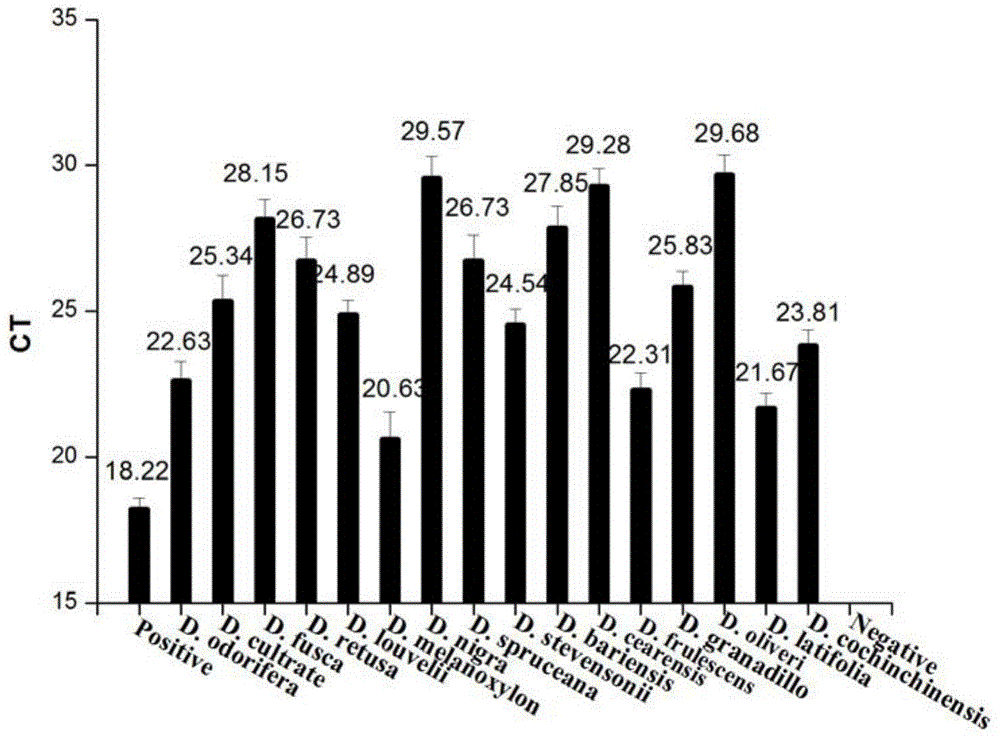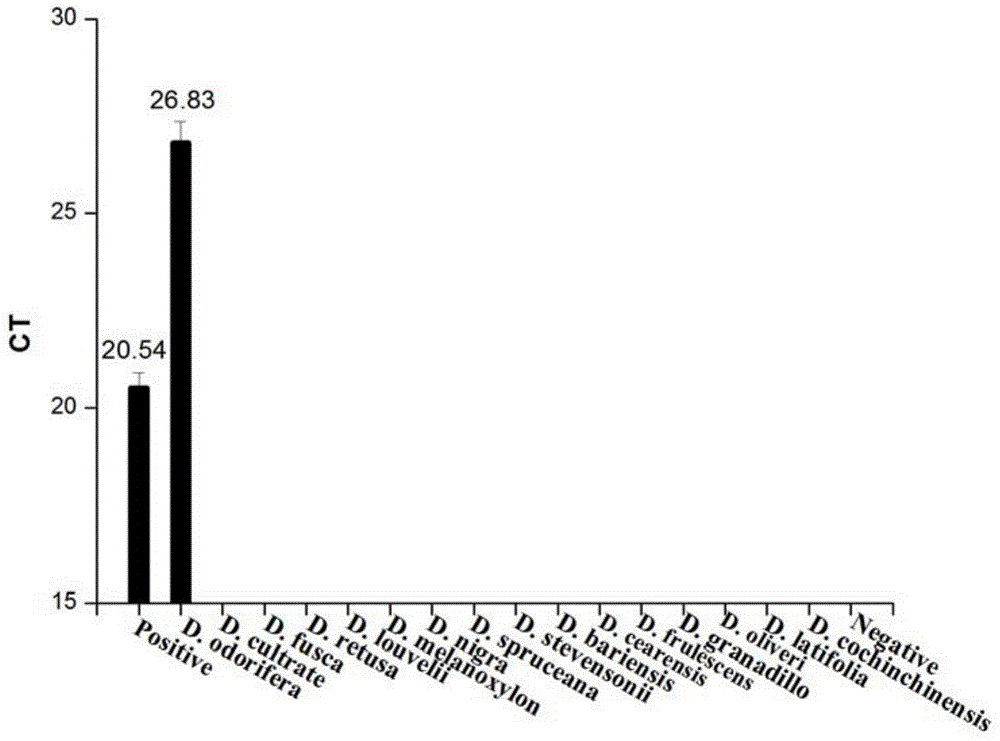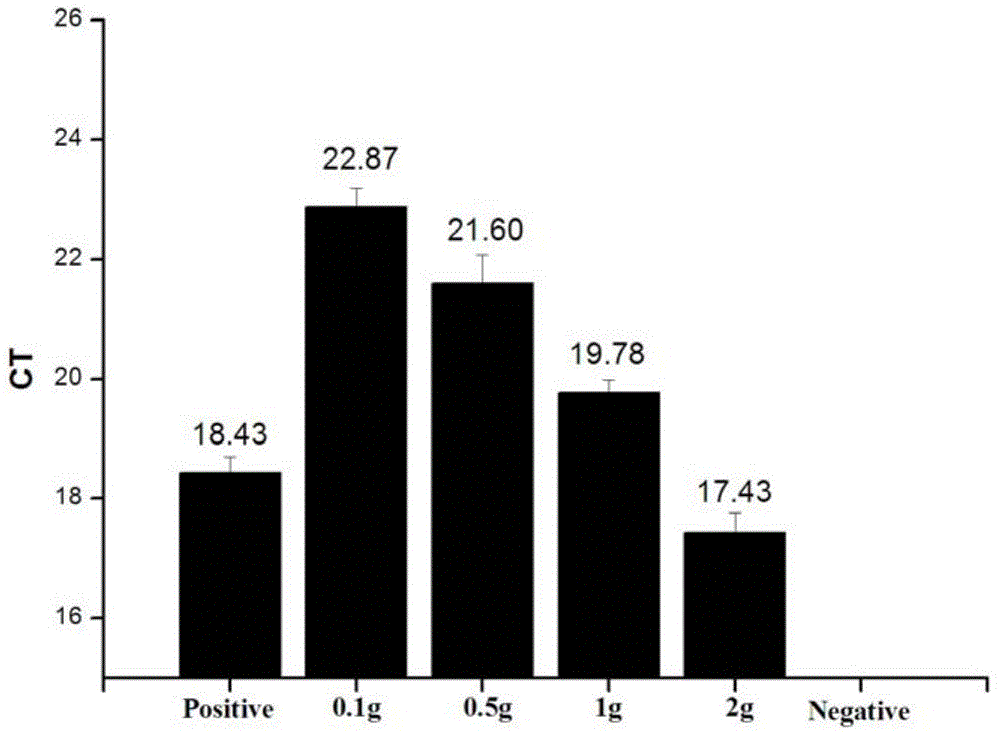Molecular identification method for dalbergia odorifera chen in rosewood, and primer and probe of molecular identification method
A technology for molecular identification and Dalbergia odorifera is applied in the field of molecular biological detection of wood species identification, which can solve problems such as difficulty in wood identification accuracy, similar material structure, etc., to meet the requirements of rapid screening and identification, stable and stable. Hybridization and improved detection sensitivity
- Summary
- Abstract
- Description
- Claims
- Application Information
AI Technical Summary
Problems solved by technology
Method used
Image
Examples
Embodiment 1
[0031] Example 1 detects the primers, probes and detection kits of Dalbergia japonica
[0032] Use resource information such as NCBI to find out the gene difference sites between Dalbergia balsamicus and other woods, screen out a pair of specific amplification primers (JXHTPrimer-F and JXHTPrimer-R), and use A specific probe (JXHTPrimerProbe) is set. The amplification primer pair and the probe sequence are respectively:
[0033] JXHTPrimer-F: 5'-ACGGTGGTTGAGCGTGTT-3'
[0034] JXHTPrimer-R: 5'-CTAGGGGAATCCTCGTTAGTTT-3'
[0035] JXHTPrimerProbe: 5'-VIC-TCATGAGGGCGGCCT-MGB-3'
[0036] A kit for detecting Dalbergia balsamicus, said kit comprising sample DNA extraction reagents, qPCR amplification reaction solution, positive control substance, negative control substance and blank control substance.
[0037] Wherein the qPCR amplification reaction system is: a 20 μl system comprising:
[0038] SYBRPrmixTaqⅡ (2×) 10 μl
[0039] ROX Reference Dye II (50×) 0.4 μl
[0040] JXHTPr...
Embodiment 2
[0051] Embodiment 2: the identification method of real-time fluorescent PCR
[0052] (1) Pretreatment of wood samples:
[0053] Thoroughly disinfect the wood surface with 75% ethanol, rinse with sterile water and wipe the wood dry. Cut off the surface of the wood to be tested to avoid contamination by other organizations. Take a certain amount of wood samples, add liquid nitrogen and quartz sand to a pre-cooled mortar and grind them into powder for later use. If not used immediately, the sample DNA solution was stored at -20°C until use.
[0054] (2) DNA extraction of wood samples:
[0055] The total DNA of the wood pretreated in step (1) was extracted using the Plant Genome Extraction Kit (PlantGenomicDNAKit, TIANGEN), and placed in a -40°C refrigerator for later use.
[0056] (3) Real-time fluorescent PCR amplification:
[0057] The DNA extracted in step (2) was subjected to qPCR detection. The amplification conditions are: 95°C, 2min; 95°C, 15s, 55°C, 34s, a total of ...
Embodiment 3
[0064] Embodiment 3: DNA extraction and detection
[0065] Dalbergia Dalbergia (experimental group 1), control group: Dalbergia chinensis, black Dalbergia, broad-leaved Dalbergia, East African Dalbergia, Brazilian Dalbergia, Amazon Dalbergia, Belize Dalbergia, Dalbergia chinensis, Dalbergia barry, Dalbergia saichuan, Dalbergia cochinchinensis, Dalbergia tomentosa, Central American Dalbergia, Dalbergia austenifolia, and Dalbergia dentata, a total of 15 control genomic DNAs were used as templates, using the plant The source gene tRNALeu and the reaction system of Example 1 and the identification method described in Example 2 are used to detect the extracted DNA.
[0066] The primer and probe sequences of tRNALeu are (standard):
[0067] tRNALeu-F: 5'-CGAAATCGGTAGACGCTACG-3'
[0068] tRNALeu-R: 5'-TTCCATTGAGTCTCTGCACCT-3'
[0069] tRNALeuProbe: 5'-FAM-GCAATCCTGAGCCAAATCC-TAMRA-3'
[0070] like figure 1 It shows that the DNA of the samples of the experimental group and the c...
PUM
 Login to View More
Login to View More Abstract
Description
Claims
Application Information
 Login to View More
Login to View More - R&D
- Intellectual Property
- Life Sciences
- Materials
- Tech Scout
- Unparalleled Data Quality
- Higher Quality Content
- 60% Fewer Hallucinations
Browse by: Latest US Patents, China's latest patents, Technical Efficacy Thesaurus, Application Domain, Technology Topic, Popular Technical Reports.
© 2025 PatSnap. All rights reserved.Legal|Privacy policy|Modern Slavery Act Transparency Statement|Sitemap|About US| Contact US: help@patsnap.com



